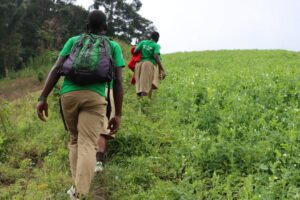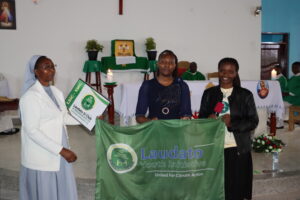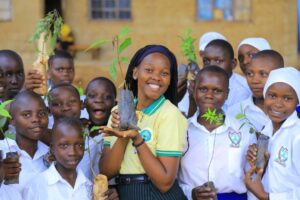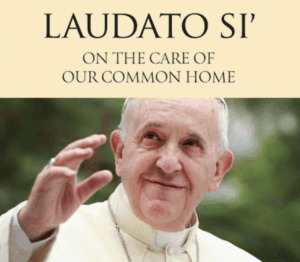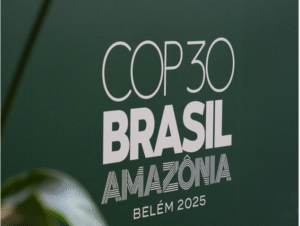By Laudato Voices | September 22, 2025.
Uganda is poised at a critical juncture, where rising ecological stressors, including climate change, biodiversity loss, soil degradation, and water scarcity, directly threaten livelihoods, particularly in agriculture-dependent communities. Simultaneously, national development efforts such as Vision 2040, the National Development Plan III, and the reform of Uganda’s education curriculum offer a ripe moment to institutionalize environmental education (EE) at all levels.
However, Uganda possesses a youthful population, rich biodiversity, and emerging policy frameworks, such as the competence-based curriculum and the Catholic Church’s recently proposed climate resilience model, MAST (Mitigation, Adaptation, Societal Transformation). In this context, integrating environmental education (EE) into national curricula at all levels presents an untapped opportunity. This integration could cultivate innovators in agricultural science and biological systems, enhance livelihoods, and reinforce ethical and ecological values, especially as articulated in Laudato Si’. This article synthesizes current developments, empirical insights, and moral-theological resources, arguing for urgent educational reform and cross-sector collaboration.
Environmental education (EE) refers to the structured inclusion of ecological knowledge, sustainability values, adaptive skills, and responsible behaviors into learning processes. It enables individuals and communities to understand and act within complex human-environment systems. In Uganda, environmental themes are scattered across curricula. At the primary level, learners encounter topics like sanitation, plant and animal care, and environmental protection. At the secondary level, issues such as climate change and disaster risk reduction appear as cross-cutting themes (CRIN, 2021). However, these inclusions are often partial, inconsistently taught, and disconnected from real-world innovation, scientific application, or livelihood impact.
What is urgently needed is a coherent, progressive EE framework embedded across all education levels, primary, secondary, vocational, and tertiary, linking biological and agricultural sciences, climate adaptation, indigenous knowledge, and moral ecology.

Laudato Youth Initiative
Laudato Initiative leaders, while at the Vatican resilience summit, presented hope for the young people in integrating science and innovation, dialogue in cultural and religious Knowledge systems, carrying forward traditional belief systems, and story telling which we use as a tool to share both indigenous and modern knowledge.
Encouraging institutions and corporate organisations to invest in green initiatives for corporate social responsibility will enhance climate education at the grassroots levels. Companies like Foresters House Consults, Avail Fruits of Faith Farm, Bethany Lands Institute, etc, have understood the importance of this program.
We believe in African-tailored solutions and bring to play an African interpretation of Laudato Si’s integral ecology, focusing on youth-led educational programs that run from institutions to grassroots communities with a stow of experiences and indigenous wisdom as key drivers of imparting climate resilience values and sustainable development. This vision aligns directly with the need to embed environmental education across Uganda’s curricula, particularly by recognizing that schools can become hubs for ecological innovation grounded in both traditional knowledge systems and modern science.
Our Laudato Si Clubs foster an integrated approach that combines nature-based and technology-based solutions, such as regenerative agriculture and renewable energy, while rejecting harmful or extractive practices that prioritize short-term profit over people and the planet. We had wonderful eco science exhibitions that demonstrated these realities. So holistic solutions should be taught in schools to cultivate informed, ethical, and resilient innovators.
Recently, SECAM emphasized the need for a just transition to clean energy, particularly community-driven solar power, as a strategy to alleviate energy poverty, empower youth and women, and reduce carbon emissions. By aligning with this call, Uganda’s educational system could prepare learners not only for green jobs but also for ethical leadership in the renewable energy sector. Our Laudato Youth have already ventured into technological innovations that show much progress.
At the heart of the Laudato Youth Initiative’s message is a spiritual imperative: climate action is a moral responsibility. Laudato Si’ and Laudate Deum inspire commitments to ecological conversion in schools, universities, parishes, dioceses, and grassroots communities across Uganda. This reinforces our argument that environmental education must integrate ethical, cultural, and spiritual dimensions, particularly in Uganda’s faith-driven education landscape, where St. Adolf Mukasa Rudigo is revered as the patron of ecology and yardsmen.
Finally, our commitment to inspiring a faith-inspired climate education model, advocating at national climate forums, and strengthening partnerships with like-minded ethical actors like Bethany Lands Institute, Forester Hse Consults, Avail Fruits of Faith Farm, John Paul II Justice and peace Centre is the kind of institutional coordination that Uganda’s education system must embrace to foster transformative, community-rooted, and ecologically literate citizens that echoed our vision and amplifies the voices for deep integration of environmental education into Uganda’s curricula. It affirms that educational institutions, Churches, and grassroots communities must become platforms for ecological conversion, innovation, climate resilience, and moral leadership, empowering Uganda’s youth to rise as agents of transformation in their communities and beyond.

Why Deeper Integration of Environmental Education Matters
2.1 Responding to Climate and Ecological Threats
Uganda faces intensifying threats from deforestation, erratic rainfall, prolonged droughts, flash floods, and biodiversity loss. These directly impact food systems, health, and rural economies. For example, smallholder farmers face reduced yields due to degraded soils, unpredictable seasons, and increased pests. Without scientifically informed education that includes adaptive strategies, communities remain vulnerable to environmental shocks (CRIN, 2021).
2.2 Unlocking Youth Potential for Innovation
Youth in Uganda are already demonstrating capacity for climate-smart innovation. In 2025, over 50 youth submitted hardware and software innovations in the Chicken Value Chain Climate Resilient Innovation Challenge. The winning entry, “Smart Kuku Brooder,” used thermal regulation technology to reduce poultry mortality linked to climate variability (Muzardi & Gudie Leisure Farm, 2025). Similarly, Swisscontact’s EcoProsperity Project has trained over 12,000 youth in regenerative farming and market-oriented agriculture (Swisscontact, 2025). These initiatives prove that when equipped with knowledge, tools, and space, youth can drive sustainable transformation. Also, at our recently concluded Laudato Si Green Festival in Jinja, students showcased edge-cutting innovations, including “Laudato Ai” designed purposely to educate people about the environment
2.3 Alignment with Uganda’s Competence-Based Curriculum
Uganda’s new competence-based curriculum emphasizes inquiry, problem-solving, and practical skills. These principles naturally support the integration of environmental education across disciplines. When EE is treated as a cross-cutting domain embedded within science, agriculture, biology, geography, social studies, ethics, and indigenous knowledge, it fosters hands-on, locally relevant learning (Asiimwe, Natamba, & Mukasa, 2022). This integration aligns well with Uganda’s goals of fostering critical thinkers, problem solvers, and lifelong learners.
2.4 Moral and Spiritual Motivation: Laudato Si’
The ecological encyclical Laudato Si’ (Pope Francis, 2015) calls for an “ecological conversion,” urging humanity to recognize the interconnectedness of life, the rights of future generations, and the cry of the poor and the earth. In Uganda, these ideas have taken root through the Laudato Youth Initiative, the One Million Tree Planting Campaign, and the formation of Laudato Si’ clubs in schools and universities (Laudato Youth Initiative, 2025). Faith-based organizations have become not only moral voices but practical actors leading tree planting drives, establishing agroecology projects, and advocating for ecological justice.
2.5 Economic and Livelihood Opportunities
Environmental education can drive green entrepreneurship. Examples include bio-briquette production, waste-to-income initiatives, school-based agroforestry, and value-added biological enterprises like seed banks and native tree nurseries. SOS Children’s Villages’ Eco Champions programme shows that even youth in vulnerable communities can convert environmental threats such as plastic pollution into profitable ventures (UNICEF Uganda, 2024). Environmental literacy thus becomes a pathway to economic inclusion.
The MAST Framework: A Model for Curricular Design
The MAST framework, Mitigation, Adaptation, and Societal Transformation, offers a powerful approach to structuring environmental education (CIFOR-ICRAF, 2023).
- Mitigation involves teaching learners about sustainable land use, reducing deforestation, carbon cycling, and clean energy systems.
- Adaptation equips them with knowledge on resilient crops, water harvesting, agroecology, and integrated pest management.
- Societal Transformation addresses ethics, behavior change, indigenous wisdom, gender equity, faith, and community stewardship.
A curriculum informed by MAST produces not only technically skilled graduates but also socially and spiritually grounded innovators.
Empirical Cases Illustrating the Potential of EE
4.1 Smart Agriculture and Biological Systems Thinking
In Kyenjojo, Laudato Youth members at St.Adolf Parish introduced intercropping systems using indigenous drought-resistant crops and integrated animal feeding strategies linking crop residues to small ruminant nutrition. This demonstrates local biological systems innovation rooted in ecological understanding (Laudato Youth Initiative, 2025).
4.2 Youth-led Green Innovation Challenges
The Chicken Value Chain Innovation Challenge produced devices like solar incubators and automated thermal regulators. These innovations combine biology, energy efficiency, and animal science, underscoring the role of EE in catalyzing technical solutions (Muzardi & Gudie Leisure Farm, 2025).
4.3 Green Entrepreneurship by NEET Youth
UNICEF’s BEAD programme has supported youth in turning environmental degradation into enterprise: transforming aquatic weeds into fertilizers, and plastic waste into reusable materials. These examples highlight how EE can reach even youth outside formal education (UNICEF Uganda, 2024).
Untapped Opportunities for Scalable Innovation
5.1 Establishing Living Laboratories in Schools
Every school could serve as a green learning hub with gardens, agroforestry plots, biodiversity observatories, water harvesting systems, and weather stations. Such labs link theory to practice and nurture innovation ecosystems.
5.2 Integrating EE with ICT and Emerging Technologies
Recent research on smart farming in Uganda demonstrates how IoT sensors, data science, and predictive models can guide decisions on soil, rainfall, and crop cycles (Nomugisha & Mwebaze, 2025). Integrating these tools into curricula would empower learners to become tech-savvy environmental problem solvers.
5.3 Valorizing Indigenous Knowledge Systems
Formal curricula often neglect local ecological wisdom. Incorporating indigenous practices such as traditional soil conservation, herbal medicine, water rituals, and planting calendars not only preserves cultural heritage but enhances sustainability and learner identity (Asiimwe et al., 2022).
5.4 Building Bridges Between Universities, TVETs, and Communities
Higher education institutions can act as innovation hubs by collaborating with communities through co-ops, research labs, and incubators. For instance, partnerships between Makerere University and NARO could lead to student-led agritech solutions for smallholder farmers. Our partnership with the Bethany Lands Institute could lead to quick ecological conversion in Luwero as we plan to roll out 12 Laudato Si Clubs in the area to educate young people about integral ecology.
5.5 Reforming Teacher Training and Policy
To scale EE, teachers must be trained in climate science, agroecology, hands-on learning, and ethical pedagogy. Curriculum reforms must be accompanied by new assessment models, resource allocation, and policy mandates for environmental literacy at every level. Laudato Youth Initiative continues its program of training teacher patrons and parish club leaders.
Policy Recommendations
To fully leverage environmental education, Uganda should:
- Enshrine environmental literacy as a national education goal.
- Integrate EE across all disciplines, including agriculture, science, arts, ethics, and indigenous studies.
- Invest in teacher training, hands-on pedagogies, and local resource development.
- Equip schools with green infrastructure gardens, labs, ICT, and monitoring tools.
- Support youth-led innovation challenges and green business incubation.
- Foster collaboration between schools, universities, CSOs, and faith organizations.
- Align educational reforms with national climate, agriculture, and development strategies, particularly the Green Growth Strategy and Vision 2040.
- Establish national indicators for EE uptake, innovation, and impact.
The full integration of environmental education into Uganda’s national curriculum is not just an educational improvement; it is a national development strategy. It holds the promise of generating a generation of innovators capable of addressing agricultural challenges, protecting biodiversity, building resilient communities, and transforming environmental threats into livelihoods. The evidence from Uganda’s youth, faith-based movements, and pilot projects demonstrates the country’s readiness. With frameworks like MAST and values from Laudato Si’ guiding the way, Uganda can lead Africa in turning environmental education into environmental transformation.
References
Asiimwe, F. M., Natamba, S., & Mukasa, S. (2022). Integrating indigenous knowledge into Uganda’s primary school curriculum: Strategies for decolonisation and cultural reclamation. East African Journal of Education Studies.
Children’s Rights International Network. (2021). Children’s access to justice for environmental rights—Uganda: Children’s rights in education. https://home.crin.org/issues/environmental-rights
Gudie Leisure Farm & MUZARDI. (2025). Chicken value chain climate resilient innovation challenge. National Agricultural Research Organization (NARO).
Laudato Youth Initiative. (2025). Laudato Si’ clubs and the One Million Tree Planting Drive in Uganda. https://laudatoyouthuganda.org
Nomugisha, G., & Mwebaze, J. (2025). A smart IoT framework for climate-resilient and sustainable maize farming in Uganda.
Swisscontact Uganda. (2025). EcoProsperity Project: Climate-resilient agriculture initiative in Uganda. https://www.swisscontact.org/en/projects/ecoprosperity
UNICEF Uganda. (2024). NEET youth innovate through green solutions and 21st-century skills. https://www.unicef.org/uganda/reports










